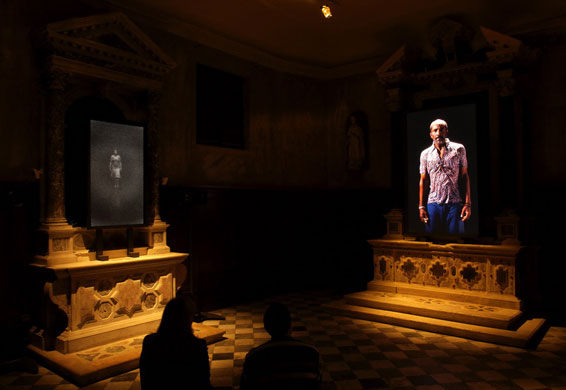“The Self is an ocean without a shore. Gazing upon it has no beginning or end, in this world and the next.” Ibn al’Arabi (1165-1240)
This small line gave Bill Viola the perfect name for his 2007 video installation made specifically for the Church of San Gallo in Venice, in honour of the 52nd International Art Exhibition La Biennale di Venezia. [1]
The video and sound installation consists of two 65” plasma screens, one 103” vertical plasma screen and six loudspeakers. [2] Due to modern video technology, Viola was able to shoot the sequence in both colour and black and white. The installations shows several people (one per screen) standing behind a thin, almost mirror like sheen of water, shown in gritty black and white. Slowly, they move forwards, to the sheen of water, the almost invisible barrier separating the figures from the audience. Once they break through this barrier, they appear in brilliant colour, soaked to the bone, yet not at all happy at having gotten through to the audience. Slowly, they turn around and return to ‘where they came from’, passing through the water shield and retracting from view.
Bill Viola himself states his reasoning eloquently, be saying that:
“The video sequence describes the human form as it gradually coalesces from within a dark field and slowly comes into view, moving from obscurity into the light. As the figure approaches, it becomes more solid and tangible until it breaks through an invisible threshold and passes into the physical world. The crossing of the threshold is an intense moment of infinite feeling and acute physical awareness. Poised at that juncture, for a brief instant all beings can touch their true nature, equal parts material and essence. However, once incarnate, these beings must eventually turn away from mortal existence and return to the emptiness from where they came.” [3]
His work is about the presence of death within our lives, and his first showing in the Church of San Gallo, the three plasma screens poised above three altars makes this motif of death and the resurfacing of the dead more striking and poignant than ever before.
Over 24 performers were used for this piece, and Viola was aided by 20 technical personnel, making sure the recording ran along smoothly. [4]

Viola was inspired to create this artwork by a 20th century poem by Senegalese poet and storyteller Birago Diop: [5]
Hearing things more than beings/ listening to the voice of fire/ the voice of water/ Hearing in wind the weeping bushes/ sighs of our forefathers.
The dead are never gone/ they are in the shadows/ The dead are not in earth:/ they’re in the rustling tree/ the groaning wood/ water that runs/ water that sleeps/ they’re in the hut, in the crowd/ the dead are not dead.
The dead are never gone/ they’re in the breast of a woman/ they’re in the crying of a child,
in the flaming torch/ The dead are not in the earth/ they’re in the dying fire/ the weeping grasses/ whimpering rocks/ they’re in the forest, they’re in the house/ the dead are not dead.
Ocean Without a Shore stands at the centre of the focus of Viola’s world, namely “the sentient self and its manifold rites of passage.” [6]
Ocean Without a Shore can be compared to Peter Campus’s Interface. [7] Campus’s work focuses on the distorted representation of the self, however, whereas Ocean Without a Shore focuses on the distorted representation of the ‘other’, the realization of identities past, dead and gone, slowly returning to the mortal realm. Interface does confront us, however, with the uncertainty of our own identity, the distorted image of the self, the impossibility to pinpoint ourselves in one specific point in time. This ‘passing’ of self can be linked to the ‘passing’ of life in Viola’s work, and both artworks can make the audience painfully realize their own finite nature. In short, we – be it our corporeal form or our identies – will all fade, die.
The fascination Viola seems to have with water is also expressed in his work He Weeps For You, [8] were the distorted representation of the self, the filtered/altered/mirrored image of one self, through the use of water, gives us a glimpse into ‘the other side’. This ‘other side’ is more fully explored in Ocean Without a Shore
Viola has also stated that “[t]oday, development of self must precede development of the technology or we will go nowhere – there will be condominiums in data space […] Application of tools are only reflections of the users – chopsticks may be a simple eating utensil or a weapon, depending on who uses them.” [9] This makes clear that, even though Viola uses state of the art video technology to make his installations, he never loses sight of his main goal: the development of self. Exploring oneself will always be more important than using the latest and greatest technologies.
Viola shows with Ocean Without a Shore that he is, once again, a person who uses “chopsticks” as a weapon, who uses video art as a means to make an audience question themselves and their identity/mortality.
Links:
Sources:
[1] Villarreal, Ignacio ‘Bill Viola Creates Work for Venice Biennale’ ArtDaily.org. (2 May 2007) Retrieved from http://artdaily.com/indexv5.asp?int_sec=2&int_new=20094
[2] Viola, Bill. ‘Ocean Without a Shore’. Retrieved from artist’s website: http://www.billviola.com/
[3] [4] Villarreal, Ignacio ‘Bill Viola Creates Work for Venice Biennale’ ArtDaily.org. (2 May 2007) Retrieved from http://artdaily.com/indexv5.asp?int_sec=2&int_new=20094
[5] ‘Ocean Without a Shore’. National Gallery of Victoria. Retrieved from http://www.ngv.vic.gov.ai/billviola/index.html
[6] Anfam, David. ‘Introduction’. Ocean Without a Shore Website. Retrieved from http://www.oceanwithoutashore.com/
[7] Campus, Peter. Interface. As found in Shanken, Edward. Art and Electronic Media. London: Phaidon, 2009: p 104
[8] Viola, Bill. He Weeps for You. As found in Shanken, Edward. Art and Electronic Media. London: Phaidon, 2009: p107
[9] Viola, Bill. ‘Will there be condominiums in data space?’ As found in Shanken, Edward. Art and Electronic Media. London: Phaidon, 2009: p 219
